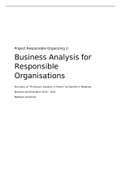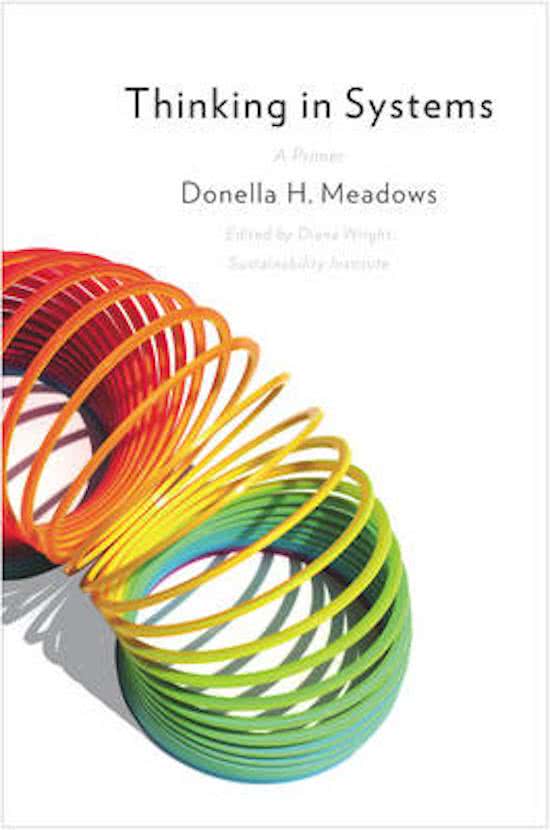Project Responsible Organizing 2:
Business Analysis for
Responsible
Organisations
Summary of “Thinking in Systems, A Primer” by Donella H. Meadows
Business administration 2020 – 2021
Radboud university
,Chapter 1: The Basics
System Interconnected set of elements, coherently organized in a way that
achieves something. System is more than the sum of its part. Are self-
organizing and can be self-repairing to some extent.
Interconnections Are the relationships that hold the elements together. Operate through
flow of information, these flows hold systems together and have an
influence on how the system operates.
System Often not explicitly stated, but deducted from behavior of the system.
function/purpose System purpose need to be alike to human purposes. Systems can be
nested systems. Therefore, there can be purposes within purposes.
Function/purpose is the most crucial part in a systems’ behavior
because it determines the fundamentals of a system.
Stock Foundation of any system. Element of the system that you can see,
feel, count or measure at any given time. It is an accumulation of
resources that has built up/depleted, does not have to be physical
resources. This accumulation allows flows to be out of balance with
each other until the stock is depleted.
Flow Influences stocks. Flows are what increases or decreases stocks, e.g.
births and deaths, purchases and sales, growth and decline, etc.
Rule of thumb: If sum of inflows > sum of outflows, stocks will rise
stocks and flows If sum of inflows < sum of outflows, stock will fall
If sum of inflows = sum of outflows, stock will stay equal
Delay, buffer, Stocks take time to change, since flows take time to flow. Stocks
absorber change slowly, even if the in- or outflow changes suddenly. Stocks
can thus be seen as delays, buffers or absorbers in the system.
Feedback loop Mechanism that causes a behavior to persist over time, constant
behavior. It is a consistent behavior pattern over a long period of time.
Feedback loop is created when changes in the size of a stock affect
the in- or outflows to and from that same stock.
Balancing Common kind of feedback loop. Stock level may not stay fixed, but
feedback loop stays in a certain range. Balancing loops are goal-seeking or stability-
seeking, trying to keep a stock at a value within a range. Balancing
feedback loop opposes whatever direction is imposed on the system.
Reinforcing Is amplifying/reinforcing/self-multiplying/snowballing. Vicious circle
feedback loop that causes growth or destruction. The bigger the stock, the more in-
or outflow to and from that same stock. Often found in systems where
stocks can reinforce or reproduce itself. Enhances whatever direction
is imposed on the system.
2
, Chapter 2: A brief visit to the Systems Zoo
Stock with two Information delivered by a feedback loop can only affect future
balancing loops behavior, it can’t have an impact fast enough to respond to current
behavior. A flow will always result in a delay in responding. Flows
can’t instantly react to flows or changes in a stock, only after a small
delay. With two balancing feedback loops, a stock-maintaining
balancing feedback loop must set a goal to compensate for inflows or
outflows that affect the stock.
Stock with one System behavior gets complex if relative strengths of loops shift,
reinforcing loop causing a shift between the dominant behavior of the system. This is
and one called shifting dominance.
balancing loop
Reinforcing loop dominates balancing loop exponential
growth
Balancing loop dominates reinforcing loop depletion of
stock
Equal strengths of balancing and reinforcing loop stable
stock
System analysis Analysis to test scenarios to see what happens if driving factors
change. These studies are not used to predict the future, but to
explore what would happen in a range of ways.
System utility The utility of a system isn’t determined by the degree of realistic
scenarios, but by the degree of a realistic pattern of behavior
System delays Multiple types of delay:
Perception delay = human delay of seeing an actionable point
(higher sales, waiting a few days to see the trend, increase
inventory)
Response delay = not taking all necessary actions at once in
fear of overdoing. Initial action is adjusted (place an order, wait
a few days and confirm increasing trend, order more).
Delivery delay = delay between ordering and receiving an
order.
Delays make systems likely to oscillate (= fluctuate). Delays are
strong determinants of system behavior. Changing the lengths of
delays can thus make a large impact in system behavior.
Two-stock Renewable stock constrained by non-renewable stock
systems
Entities operate in an environment and will therefor always run into
some kind of constrain of the entity. This constraint can take the form
of a balancing loop and can shift the dominance by strengthening the
outflow or by weakening the outflow. Constraints can be temporary or
permanent and an organization may work around constraints,
however sooner or later there will be an inevitable constrain. The
3






